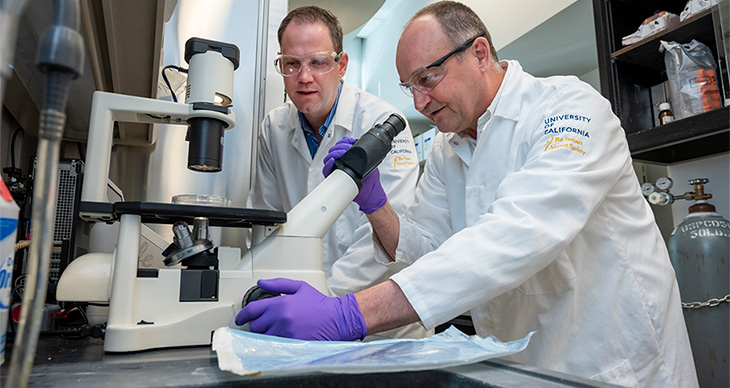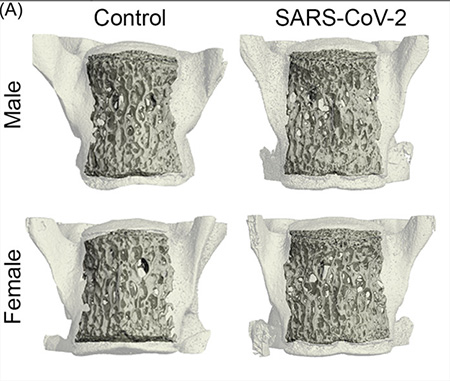A UC Davis Health study that looked at acute bone loss in mice who had COVID-19 showed that SARS‐CoV‐2 infection can cause significant changes in bone structure. The study is the first to suggest that people with COVID‐19 may experience long‐term orthopedic issues, such as decreased bone mass, increased fracture risk and other musculoskeletal complications.
"Our study provides direct evidence that SARS‐CoV‐2 infection leads to acute bone loss, an increased number of osteoclast bone cells, and thinner growth plates," said senior author of the study, Dominik Haudenschild, professor emeritus in the Department of Orthopaedic Surgery at UC Davis Health.
In the study, mice who had COVID-19 showed significant bone loss. This loss decreased the bone mechanical strength and increased the risk of fractures. If similar bone loss occurs in human patients following their COVID‐19 recovery, it could leave them with a long‐term — even permanent — increased risk of fractures due to fragile bones. This is especially true in elderly patients.
Fragility fractures are breaks that happen due to minor trauma, such as when a person falls from standing height or less. The study suggested that the higher risk of fragility fractures may be one of the underreported long-haul symptoms of COVID-19.
"This study has profound clinical implications," said R. Lor Randall, professor and chair of the Department of Orthopaedic Surgery. "Musculoskeletal ramifications of COVID may not be the first medical issue that comes to mind when one thinks about the pandemic. Nevertheless, many people suffer from fragile bones and COVID can put them at an even greater risk for fracture."

Method
The study examined the bone structure of SAR-CoV-2 infected (12 male and 12 female) and non-infected (four male and four female) mice. It also measured the viral burden of the coronavirus in the infected mice using throat swabs from days 1, 2 and 3 post infection and in their brain and lungs.

The researchers also assessed whether a protein linked to SARS‐CoV‐2 infection was detected in the joint tissues. Its presence would indicate that the SARS‐CoV‐2 reached these tissues and infected the various cell types. They found that bone and joint tissues are susceptible to viral infection. The protein was identified in cells in the joint's connective tissue (synovium), bone marrow, and the distal femoral growth plate. It was also found in the lung.
The study also showed that SARS‐CoV‐2 infection was associated with significant changes to the trabecular bone microstructure in infected male and female mice.
"The data from the study are the first confirmation of the harmful effect of SARS‐CoV‐2 infection on the bones, from resorption (tissue breakdown) to growth plate thinning," Haudenschild said. "This means that bone loss and growth disturbances may be serious complications of COVID‐19."
How does COVID-19 hurt the bones?
The researchers suggested multiple ways that COVID-19 may affect the bones. For example, the SARS-CoV-2 virus triggers the immune system to produce pro-inflammatory proteins known as cytokines. These cytokines can lead to hyperinflammation that may contribute to various bone and joint diseases.
Long‐term bed rest and decreased physical ability could lead to bone loss due to lack of use. In addition, COVID patients treated with corticosteroids could also experience significant bone loss during their treatment.
The study was funded by awards from the Department of Defense Congressionally Directed Medical Research Program (PR200947, PR171305, PR180268) and the National Institute of Arthritis and Musculoskeletal and Skin Diseases (AR071459, AR075013). It also received support from the Office of Research, the Schools of Medicine and Veterinary Medicine at the University of California, Davis.
The co-authors of this study are Anne Haudenschild, Blaine Christiansen, Erin Ball, Christopher Weiss, Hongwei Liu, Jasper Yik, and Lark Coffey.






